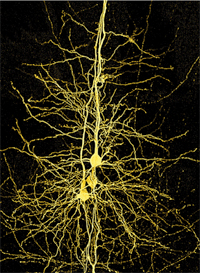Mind over matter
A Swiss neuroscientist and his plan to build a human brain model from software

Henry Markram recalls the reaction of the media and the research community when he announced the eventual goal of his Blue Brain Project: building a biologically accurate software replica of the human brain. “They said it was complete B.S.,” he said with a smile, conceding that a biologically accurate computer simulation of the world’s most complex structure is more than just a few years away.
“The Blue Brain Project is probably going to outlive all of us,” said Markram, codirector of the Brain Mind Institute at the Federal Institute of Technology in Lausanne, Switzerland, and the project’s principal researcher. “It may not be completed in our lifetime, but we can at least begin this process.”
Markram’s Blue Brain Project, which launched a year ago, is intended to make unprecedented discoveries of how the brain works by building large-scale computer models of the organ. On May 4, the Swiss neuroscientist discussed this massive undertaking at the College of Arts and Sciences department of cognitive and neural systems (CNS).
Markram told the audience that he is starting small. The first phase of the ambitious project, which uses IBM’s eServer Blue Gene supercomputer, is to build a three-dimensional computer simulation of the neocortical column (NCC) of a rat. He estimates that this will take up to two more years.
However, modeling the behavior of the 10,000 morphologically complex neurons in a rat’s NCC, which is very similar to the NCC of a human brain, is no small feat. Scientists have been able to make computer models of individual neurons, but because of its complexity, not of the NCC.
Supercomputing is enabling researchers from many scientific disciplines — especially neuroscience — to make great strides. The Blue Gene supercomputer, one of which BU acquired last year, is capable of processing 22.8 teraflops (trillion floating point operations per second). A recently as 2001, the world’s most powerful supercomputer was capable of processing only one teraflop. “I went to IBM five years ago, but it was too early,” Markram said. “Then I went to IBM again a year and a half ago, and they had a computer with enough processors.”
He predicted that the project’s modeling, aided by another supercomputer, SGI’s latest, the Altix 3000, will provide fresh insights into the neocortex, the part of the brain responsible for higher level cognitive functions, such as language, learning, and complex thought, and reveal how memories are formed, stored, retrieved, and lost. He said that the project will shed light on how vulnerabilities in the neocortex — circuit errors — lead to such disorders as autism, depression, and schizophrenia.
“Henry Markram is part of an important subset of neuroscientists who have bridged the chasm between experiment and modeling,” said Gail Carpenter, a CAS professor of cognitive and neural systems.
Predictably, Markram has his share of doubters. Some neuroscientists insist that the human brain, with 100 billion neurons, is impossible to model with biological accuracy — especially with simulations of synapses firing in real time — and that brain processes don’t work in a way comparable to those of a computer. They assert that not enough is known at the molecular level about the structure of the complex network connecting cells in the cortex. But an undaunted Markram said that although much more data are needed about the brain, building this model should help organize and accelerate this research, and that one of the project’s goals is to emulate single neurons at molecular level detail.
Furthermore, he said, there has been significant progress in the study of synaptic transmission, including the work of Stephen Grossberg, CNS department chairman, in establishing models of how the brain perceives and processes information. “We don’t know everything, but we know enough to begin to project,” he said. “We have the key building blocks to start building a model of the neocortical column.”
Markram’s talk was this year’s Center for Learning in Education, Science, and Technology (CELEST) distinguished lecture at CNS. CELEST was launched in 2004 with a $20.1 million grant from the National Science Foundation.